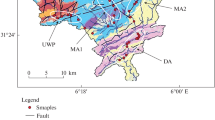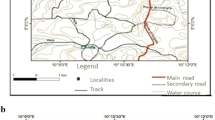Abstract
Nevada has produced one-third million tons of montmorillonite clays; a major portion was natural adsorbent clay from the Ash Meadows district. Four properties, 3 with swelling and 1 with non-swelling montmorillonite, are currently producing.
Detailed geologic and laboratory studies were made of thirty Nevada montmorillonite deposits. Pyroclastic and other volcanic rocks, mainly Miocene and Pliocene in age, were the host for most of these. The montmorillonite deposits are believed to have been formed in four ways: (1) eleven deposits by alteration of volcanic ash shortly after it settled in lacustrine basins; (2) two deposits by deposition of fine-grained clastic materials; (3) eleven deposits by hydrothermal alteration of a variety of rock types near structural channelways; and (4) six deposits by partial leaching and alteration of glassy, rhyolitic volcanic rocks by ground water.
Montmorillonite is the predominant clay mineral in all the deposits except Ash Meadows, where saponite is present. Sodium is much more common as the exchangeable cation than calcium and/or magnesium. Kaolinite and illite are present in one-fifth of the samples; chlorite or mixed-layer material are rarely present. Quartz, cristobalite, feldspars, calcite, and gypsum are common impurities.
The tests performed on the clay samples were: color; texture; slaking reaction; percentage swelling in water; plastic viscosity, yield point and gel strength of clay-water slurry; colloid content; and pH. Some montmorillonites formed by incomplete alteration of pyroclastic rocks can be wet separated to yield a light-colored, — 2μ fraction with superior viscosity and thixotropy.
Résumé
L’étate de Nevada a fourni un tiers de million de tonnes d’argiles montmorillonites; une grande partie était de l’argile naturelle adsorbante du district d’Ash Meadows. Quatre localités sont actuellement prodiutes: 3 avec montmorillonite gonflant et 1 avec montmorillonite non gonflant.
Des études détaillées de géologie et de laboratoire ont été entreprises dans trente dépôts de mont-orillonite a l’étate de Nevada. Les roches pyroclastiques et autres roches volcaniques, principalement du miocéne et du pliocène en âge, one reçu la plupart de ces dépôts, quie se seraient formés de quatre manières: (1) onze dépôts par altération de la cendre volcanique peu après qu’elle se soit déposée dans les bassins lacustres; (2) deux dépôts par sédimentation de matériaux clastiques à grains fins; (3) onze dépôts par altération hydrothermique d’une variété de types de roches proches des voies structurelles; et (4) six dépôts par filtration et altération partielles de roches volcaniques rhyolitiques hyalines par l’eau de surface.
Le montmorillonite est le minéral argileux qui prédomine dans tous les dépôts à l’exception de celui d’Ash Meadows, où la saponite est présente. Le sodium est encore plus commun, en tant que cation d’échange, que le calcium et/ou le magnésium. Le kaolin et l’illite sont présents dans un cinquième des échantillon; le chlore ou les matières à couches mixtes sont rares. Le quartz, le cristobalite, le feldspath, le calcite, et le gypse sont des impuretés communes.
Les essais effectués sur les échantillons d’argile comprenaient les essais de couleur, de texture, de réaction de ralentissement, de pourcentage de gonflement dans l’eau, de viscosité plastique, de limite de résistance et de résistance au gel de la boue argile-eau, de la teneur en colloïdes et de pH. Quelques montmorillonites formés par l’altération incomplète de roches pyroclastiques peuvent être séparés à l’état humide donnant une fraction de — 2ώ légèrement colorée avec une thixotropie et une viscosité supérieures.
Kurzreferat
Nevada hat ein Drittel einer M illion Tonnen Montmorillonit Tone produziert, wobei der Grossteil aus natürlichem, adsorbierendem Ton aus dem Ash Meadows Gebiet bestand. Vier Grudstücke, 3 mit quellendem und 1 mit nicht-quellendem Montmorillonit, sind derzeit in Produktion. Es wurden eingehende, geologische und Laboratoriumsstudien an dreissig Nevada Montmorillonit Lagerstätten durchgeführt. In den meisten Fällen bestand das Muttergestein aus pyroklastischem und anderem vulkanischem Gestein, hauptsächlich mit Ursprung im Miozän und Pliozän. Es wird angenommen, dass sich die Montmorillonitlager auf vier Arten gebildet haben: (1) elf Lager durch Veränderung vulkanischer Asche kurz nach Ablagerung in Binnenseebecken; (2) zwei Lager durch Ablagerung feinkörnigen, klastischen Materials; (3) elf Lager durch hydrothermale Veränderung verschiedener Gesteinsarten in der Nähe von Rinnen im Gefüge; und (4) sechs Lager durch partielle Auslaugung und Veränderung von glasigem, rhyolitischem Vulkangestein durch Grundwasser.
Montmorillonit ist das vorherrschende Tonmineral in all den Lagerstätten mit Ausnahme von Ash Meadows, wo Saponit vorhanden ist. Natrium wird viel häufiger als austauschbares Kation angetroffen als Calcium bzw. Magnesium. Kaolinit und Illit sind in einem Fünfte! der Proben zugegen; Chlorit oder Mischschichtmaterial wird selten angetroffen. Quartz, Cristobalit, Feldspate, Calcit und Gips sind häufige Verunreinigungen.
Die Tonproben wurden auf folgende Eigenschaften geprüft: Farbe; Gefüge; Löschreaktion; prozentuale Quellung in Wasser; plastische Viskosität; Fliessgrenze und Gelfestigkeit von Tonwasserschlamm; Kolloidgehalt; pH-Wert. Gewisse durch unvollständige Wandlung pyroklastischen Gesteins gebildete Montmorillonite können nass geschieden werden, so dass sie eine helle Fraktion von weniger als 2? mit hervorragenden Viskositäts- und Thixotropiemerkmalen ergeben.
Резюме
В шт. Невада добыто 1/3 миллиона тонн монтмориллонитовых глин; главная масса их предаставляет природный адсорбент и происходит из района Эш: Медоуз. В настоящее время на трех месторождениях добывается набухающий и на одном- ненабухающий монтмориллонит. Детальными геологическими и лабораторными исследованиями были охвачены тридцать месторождений монтмориллонита. В большинстве из них монтморил лонитовые глины залегают в пирокластических и других вулканических породах, преимущественно миоценовых и плиоценовых.
Различаются четыре пути образования монтмориллонитовых глин: 1. Изменение вулканической золы вскоре после ее осаждения в озерных бассейнах (одиннадцать место-рождений); 2. Отложение тонкого глинистого детрита (два месторождения); 3. Гидротермаль-ное изменение различных пород около структурных каналов (одиннадцать месторождений); 4. Изменение под действием грунтовых вод стекловатых риолитовых вулканических пород при ограниченном выносе оснований (шесть месторождений).
Преобладающим глинистым минералом всех месторождений является монтмориллонит; только в Эш Медоуз наблюдается сапонит. Натрий, как обменный катион, более обычен, чем кальций и (или) магний. Одна пятая часть образцов содержит каолинит и иллит; хлорит и смешаннослойные образования наблюдаются редко. К числу обычных примесей относятся кварц, кристобалит, полевые шпаты, кальцит и гипс.
Similar content being viewed by others
References
Geological Society of America (1963) Rock-Color Chart: Geol. Soc. Am., New York.
Gibbons, A. B., Hinrichs, E. N., and Botinelly, Theodore (1960) The role of impermeable rocks in controlling zeolitic alteration of tuff: U.S. Geol. Surv. Prof. Paper 400B, B473–475.
Grim, R. E. (1968) Clay Mineralogy, 2nd edn: McGraw-Hill, New York.
Keller, W. D. (1966) Geochemical weathering of rocks: source of raw materials for good living: J. Geol. Educ. 14, 17–22.
Lamar, R. S. (1953) Adsorbent clays in California: Calif. J. Mines and Geol. 49, 297–337.
MacEwan, D. M. C. (1949) Some notes on the recording and interpretation of X-ray diagrams of soil clays: J. Soil Sci. 1, 90–103.
MacEwan, D. M. C. (1961) Montmorillonite minerals in Brown (Editor) The X-ray Identification of Clay Minerals: Mineral. Soc, London, 143–207.
Middleton, Jefferson (1921) Fuller’s earth: U.S. Geol. Surv., Mineral Resources U.S., 1918, Part II, 135–140.
Mielenz, R. C., Schieltz, N. C, and King, M. E. (1955) Effect of exchangeable cation on X-ray diffraction patterns and thermal behavior of a montmorillonite clay: Clays and Clay Minerals 3, 146–173.
Nutting, P. G. (1943) Adsorbent clays: their distribution, properties, production, and use: U.S. Geol. Surv. Bull. 928-C.
Papke, K. G. (1969) Montmorillonite, bentonite, and fuller’s earth deposits in Nevada: Nevada Bur. Mines Bull., In press.
Savins, J. G., and Roper, W. F. (1954) A direct-indicating viscometer for drilling fluids: Am. Petrol. Inst., Drilling and Production Practice 7, 7–22.
Author information
Authors and Affiliations
Additional information
Publication authorized by the Director, Nevada Bureau of Mines.
Rights and permissions
About this article
Cite this article
Papke, K.G. Montmorillonite Deposits in Nevada. Clays Clay Miner. 17, 211–222 (1969). https://doi.org/10.1346/CCMN.1969.0170404
Received:
Published:
Issue Date:
DOI: https://doi.org/10.1346/CCMN.1969.0170404




